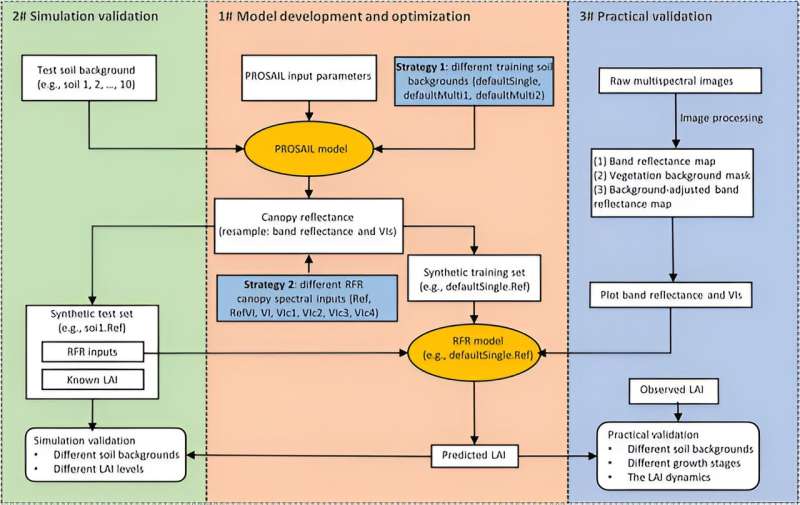This article has been reviewed according to Science X's editorial process and policies. Editors have highlighted the following attributes while ensuring the content's credibility:
fact-checked
trusted source
proofread
AI-enhanced model predicts wheat health across diverse soils using drone data

In agricultural and remote sensing research, accurately estimating wheat's Leaf Area Index (LAI) using unmanned aerial vehicle-based multispectral data is essential for monitoring crop health and growth. Traditionally, LAI measurement is accurate but laborious.
Recent advancements have introduced hybrid methods combining radiative transfer models with machine learning, showing promise due to their efficiency and applicability. However, these methods face challenges, particularly in diverse soil backgrounds, where soil-specific models are required but lack scalability.
Current research focuses on developing a "background-resistant" model for stable and accurate LAI estimation across various soil types and environmental conditions, particularly beneficial in areas with variable soil characteristics and low LAI, like dryland regions.
In May 2023, Plant Phenomics published a research article entitled "A Generic Model to Estimate Wheat LAI over Growing Season Regardless of the Soil-Type Background."
This research aimed to develop a generic machine learning-based model for predicting wheat Leaf Area Index (LAI) across diverse soil backgrounds for the entire growth season, improving upon previous soil-specific models.
The model's simulation performance was initially tested on independent synthetic data. Random Forest Regression (RFR) models trained on synthetic data showed varying performance based on soil reflectance similarity, with the baseline model achieving an R² of 0.8 on similar soil reflectance but dropping to 0.2 on dissimilar soils.
Broadening the reflectance domain of the training soil background improved the model's robustness, but enhancing canopy-spectral inputs proved more effective for stable LAI prediction across soil backgrounds. In experiments, the RFR models were tested on both synthetic and augmented data at different growth stages.
The improvement of LAI prediction was more pronounced when improving canopy-spectral inputs rather than just broadening the training soil background's reflectance domain. The defaultMulti2.VIc3 model, using an extended reflectance domain and improved canopy-spectral indicators, was selected for further evaluation due to its stability across soils and fewer input variables.
It demonstrated good estimation accuracy for different soil backgrounds but tended to overestimate LAI for values between 2 and 5 and underestimate LAI over 5. The model was further evaluated at different growth stages throughout the growing season, showing substantial improvement in prediction accuracy, especially at early and late stages. It reliably captured the seasonal LAI dynamics under different treatments in terms of genotypes, planting densities, and water-nitrogen management.
The research concluded that a background-resistant model could be effectively established using simulation data, providing stable and accurate GAI prediction from isolated UAV-based multispectral images over a wheat-growing season with diverse soil backgrounds in field conditions. This model represents a significant advancement in predicting LAI without the need for ground calibration, making it a promising tool for agricultural monitoring and management.
More information: Qiaomin Chen et al, A Generic Model to Estimate Wheat LAI over Growing Season Regardless of the Soil-Type Background, Plant Phenomics (2023). DOI: 10.34133/plantphenomics.0055
Provided by NanJing Agricultural University




















